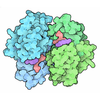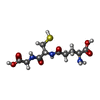+ Open data
Open data
- Basic information
Basic information
| Entry | Database: PDB / ID: 1kcg | ||||||
|---|---|---|---|---|---|---|---|
| Title | NKG2D in complex with ULBP3 | ||||||
 Components Components |
| ||||||
 Keywords Keywords |  IMMUNE SYSTEM / protein-protein complex / C-type lectin-like receptor / MHC class I-like molecule IMMUNE SYSTEM / protein-protein complex / C-type lectin-like receptor / MHC class I-like molecule | ||||||
| Function / homology |  Function and homology information Function and homology information: / negative regulation of natural killer cell chemotaxis / MHC class Ib receptor activity / natural killer cell mediated cytotoxicity / natural killer cell activation / natural killer cell lectin-like receptor binding / negative regulation of GTPase activity / positive regulation of natural killer cell mediated cytotoxicity / stimulatory C-type lectin receptor signaling pathway /  regulation of immune response ...: / negative regulation of natural killer cell chemotaxis / MHC class Ib receptor activity / natural killer cell mediated cytotoxicity / natural killer cell activation / natural killer cell lectin-like receptor binding / negative regulation of GTPase activity / positive regulation of natural killer cell mediated cytotoxicity / stimulatory C-type lectin receptor signaling pathway / regulation of immune response ...: / negative regulation of natural killer cell chemotaxis / MHC class Ib receptor activity / natural killer cell mediated cytotoxicity / natural killer cell activation / natural killer cell lectin-like receptor binding / negative regulation of GTPase activity / positive regulation of natural killer cell mediated cytotoxicity / stimulatory C-type lectin receptor signaling pathway /  regulation of immune response / MHC class I protein binding / T cell costimulation / nitric oxide biosynthetic process / viral process / DAP12 interactions / positive regulation of nitric oxide biosynthetic process / Immunoregulatory interactions between a Lymphoid and a non-Lymphoid cell / positive regulation of type II interferon production / DAP12 signaling / regulation of immune response / MHC class I protein binding / T cell costimulation / nitric oxide biosynthetic process / viral process / DAP12 interactions / positive regulation of nitric oxide biosynthetic process / Immunoregulatory interactions between a Lymphoid and a non-Lymphoid cell / positive regulation of type II interferon production / DAP12 signaling /  signaling receptor activity / signaling receptor activity /  carbohydrate binding / cellular response to lipopolysaccharide / carbohydrate binding / cellular response to lipopolysaccharide /  adaptive immune response / adaptive immune response /  cell differentiation / defense response to Gram-positive bacterium / external side of plasma membrane / cell differentiation / defense response to Gram-positive bacterium / external side of plasma membrane /  cell surface / cell surface /  signal transduction / signal transduction /  extracellular space / extracellular space /  membrane / identical protein binding / membrane / identical protein binding /  plasma membrane plasma membraneSimilarity search - Function | ||||||
| Biological species |   Homo sapiens (human) Homo sapiens (human) | ||||||
| Method |  X-RAY DIFFRACTION / X-RAY DIFFRACTION /  SYNCHROTRON / SYNCHROTRON /  MAD / Resolution: 2.6 Å MAD / Resolution: 2.6 Å | ||||||
 Authors Authors | Radaev, S. / Sun, P. | ||||||
 Citation Citation |  Journal: Immunity / Year: 2001 Journal: Immunity / Year: 2001Title: Conformational plasticity revealed by the cocrystal structure of NKG2D and its class I MHC-like ligand ULBP3. Authors: Radaev, S. / Rostro, B. / Brooks, A.G. / Colonna, M. / Sun, P.D. | ||||||
| History |
|
- Structure visualization
Structure visualization
| Structure viewer | Molecule:  Molmil Molmil Jmol/JSmol Jmol/JSmol |
|---|
- Downloads & links
Downloads & links
- Download
Download
| PDBx/mmCIF format |  1kcg.cif.gz 1kcg.cif.gz | 95.2 KB | Display |  PDBx/mmCIF format PDBx/mmCIF format |
|---|---|---|---|---|
| PDB format |  pdb1kcg.ent.gz pdb1kcg.ent.gz | 78.2 KB | Display |  PDB format PDB format |
| PDBx/mmJSON format |  1kcg.json.gz 1kcg.json.gz | Tree view |  PDBx/mmJSON format PDBx/mmJSON format | |
| Others |  Other downloads Other downloads |
-Validation report
| Arichive directory |  https://data.pdbj.org/pub/pdb/validation_reports/kc/1kcg https://data.pdbj.org/pub/pdb/validation_reports/kc/1kcg ftp://data.pdbj.org/pub/pdb/validation_reports/kc/1kcg ftp://data.pdbj.org/pub/pdb/validation_reports/kc/1kcg | HTTPS FTP |
|---|
-Related structure data
| Similar structure data |
|---|
- Links
Links
- Assembly
Assembly
| Deposited unit | 
| ||||||||
|---|---|---|---|---|---|---|---|---|---|
| 1 |
| ||||||||
| Unit cell |
|
- Components
Components
| #1: Protein | Mass: 14365.250 Da / Num. of mol.: 2 Source method: isolated from a genetically manipulated source Source: (gene. exp.)   Homo sapiens (human) / Production host: Homo sapiens (human) / Production host:   Escherichia coli (E. coli) / References: UniProt: P26718 Escherichia coli (E. coli) / References: UniProt: P26718#2: Protein | | Mass: 21125.059 Da / Num. of mol.: 1 Source method: isolated from a genetically manipulated source Source: (gene. exp.)   Homo sapiens (human) / Production host: Homo sapiens (human) / Production host:   Escherichia coli (E. coli) / References: UniProt: Q9BZM4 Escherichia coli (E. coli) / References: UniProt: Q9BZM4#3: Chemical | ChemComp-GSH / |  Glutathione Glutathione#4: Water | ChemComp-HOH / |  Water Water |
|---|
-Experimental details
-Experiment
| Experiment | Method:  X-RAY DIFFRACTION / Number of used crystals: 1 X-RAY DIFFRACTION / Number of used crystals: 1 |
|---|
- Sample preparation
Sample preparation
| Crystal | Density Matthews: 2.29 Å3/Da / Density % sol: 46.29 % | ||||||||||||||||||||||||
|---|---|---|---|---|---|---|---|---|---|---|---|---|---|---|---|---|---|---|---|---|---|---|---|---|---|
Crystal grow | Temperature: 297 K / Method: vapor diffusion, hanging drop / pH: 6 Details: PEG 8000, MES, pH 6.0, VAPOR DIFFUSION, HANGING DROP, temperature 297K | ||||||||||||||||||||||||
| Crystal grow | *PLUS | ||||||||||||||||||||||||
| Components of the solutions | *PLUS
|
-Data collection
| Diffraction | Mean temperature: 100 K | ||||||||||||
|---|---|---|---|---|---|---|---|---|---|---|---|---|---|
| Diffraction source | Source:  SYNCHROTRON / Site: SYNCHROTRON / Site:  NSLS NSLS  / Beamline: X9B / Wavelength: 0.9639, 0.9792, 0.9795 / Beamline: X9B / Wavelength: 0.9639, 0.9792, 0.9795 | ||||||||||||
| Detector | Type: ADSC QUANTUM 4 / Detector: CCD / Date: May 21, 2001 | ||||||||||||
| Radiation | Protocol: MAD / Monochromatic (M) / Laue (L): M / Scattering type: x-ray | ||||||||||||
| Radiation wavelength |
| ||||||||||||
| Reflection | Resolution: 2.6→41 Å / Num. all: 16578 / Num. obs: 16578 / % possible obs: 99.2 % / Observed criterion σ(F): 0 / Observed criterion σ(I): -3 | ||||||||||||
| Reflection shell | Resolution: 2.5→2.59 Å / % possible all: 95.6 | ||||||||||||
| Reflection | *PLUS Lowest resolution: 41 Å / Num. obs: 26678 / % possible obs: 99.7 % / Redundancy: 5.4 % / Rmerge(I) obs: 0.083 | ||||||||||||
| Reflection shell | *PLUS Highest resolution: 2.6 Å / Lowest resolution: 2.7 Å / % possible obs: 99.9 % / Redundancy: 5.2 % / Num. unique obs: 2683 / Rmerge(I) obs: 0.4 / Mean I/σ(I) obs: 3.9 |
- Processing
Processing
| Software |
| |||||||||||||||||||||||||
|---|---|---|---|---|---|---|---|---|---|---|---|---|---|---|---|---|---|---|---|---|---|---|---|---|---|---|
| Refinement | Method to determine structure : :  MAD / Resolution: 2.6→41 Å / σ(F): 0 / Stereochemistry target values: Engh & Huber MAD / Resolution: 2.6→41 Å / σ(F): 0 / Stereochemistry target values: Engh & Huber
| |||||||||||||||||||||||||
| Refinement step | Cycle: LAST / Resolution: 2.6→41 Å
| |||||||||||||||||||||||||
| Refine LS restraints |
| |||||||||||||||||||||||||
| Software | *PLUS Name: CNS / Version: 1 / Classification: refinement | |||||||||||||||||||||||||
| Refinement | *PLUS Highest resolution: 2.6 Å / Lowest resolution: 41 Å / σ(F): 0 / % reflection Rfree: 5 % / Rfactor obs: 0.22 / Rfactor Rwork : 0.22 : 0.22 | |||||||||||||||||||||||||
| Solvent computation | *PLUS | |||||||||||||||||||||||||
| Displacement parameters | *PLUS | |||||||||||||||||||||||||
| Refine LS restraints | *PLUS
| |||||||||||||||||||||||||
| LS refinement shell | *PLUS Rfactor Rfree: 0.49 / Rfactor obs: 0.386 |
 Movie
Movie Controller
Controller




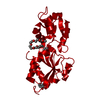
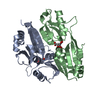
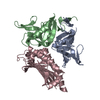
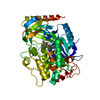
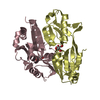

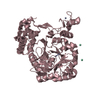
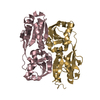

 PDBj
PDBj


